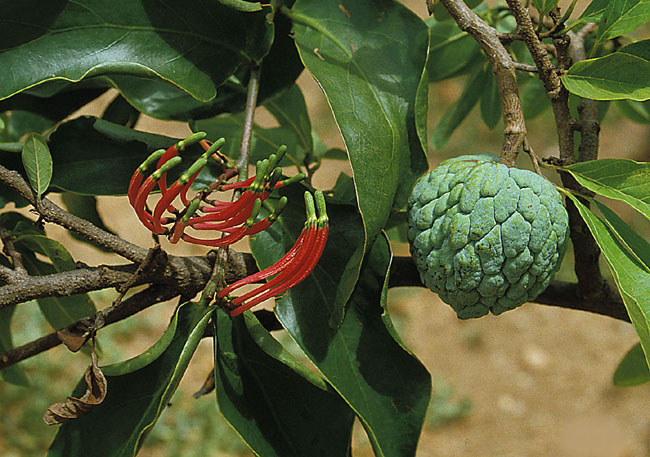
Description (Barlow 1995)
Dendrophthoe falcata (L. f.) Ettingsh.
Loranthusfalcatus L. C., Suppl. PI. (1781) 211. Dendrophthoe falcata (L. C.) Ettingsh., Denkschr. K. Akad. Wiss. M.-N. CI. Wien 32 (1872) 52. - Type: Not seen.
This name has been applied by numerous authors to a complex taxon thought to be widespread, from India to eastern Australia, and very polymorphic. Based on examination of the extensive holdings in L, it is concluded that a number of closely related but morphologically and geographically discrete species are represented by the collections referred to this complex. The exceptional biological and geographical situation supposedly represented by Dendrophthoe falcata sens. lat. is therefore not valid.
Dendrophthoe falcata sens. str. does not occur in Malesia,
and is probably of restricted occurrence in India. For further
discussion see under D. curvata, which is the most
widespread member of the species group occurring in Malesia.
-----------
1) Dendrophthoe kerrii (Craib) Barlow, comb. novo -
Loranthus kerrii Craib, Kew Bull. (1911) 453.
Description (Barlow 1974)
Dendrophthoe falcata (L. f.) Ettingsh. Densk. Akad. Wiss. Math-Nat. 32: 52 (1872); Dans. Bull. Jard. bot. Buitenz. 10: 308 (1929); 11: 403, illus. Fig. 20, d (1931); 14: 96 (1936); Blumea 3: 52 (1938); 3: 400 (1940); Barlow, Aust. J. Bot. 14: 490, illus. Fig. 7, m (1966); Loranthus falcatus L.f. Suppl. P1. 211 (1781); Engl. & Krause, Pfl. Fam.ed. 2 16b: 153 (1935). Type-Not seen.
Loranthus longifiorus Desr. in Lam. Enc. Meth. bot. 3: 598 (1789). Type.- Not seen.
Loranthus lauterbachii Schum. in Schum. & Lauterb. Fl. Deutsch. Schutzgeb. 299 (1901). Type-New Guinea, Cape Ancona, Huon Gulf, Lauterbach 666, 2.viii. 1890 (B, holotype, not seen, probably destroyed; WRSL).
Loranthus dolichocladus Schum. in Schum. & Lauterb. Nachtr. 1: 258 (1905); Fngl. & Krause, Pfl. Fam.ed. 2 16b: 153 (1935): Type-New Guinea, Friedrich Wilhelmshafen, Nyman 1068, Oct. 1899 (B, holotype, not seen, probably destroyed; WRSL).
For very extensive further synonymy, not relevant
to the area dealt with here, see Barlow, Aust. J. Bot. 14: 490
(1966) and especially Danser, Bull. Jard. bot. Buitenz. 11: 403
(1931).
Glabrous except for the young shoots, inflorescences and flowers
(especially the calyces) sparsely to densely white- or brown-tomentose.
Petiole distinct, 0 5-1 . 5 cm long; lamina variable but mostly
broad lanceolate to elliptical, mostly widest in the middle, (3)-6-12-(15)
by (l)-3-5-(7) cm, attenuate at the base, obtuse or shortly rounded
at the apex; venation distinct or obscure. Inflorescences solitary
to few in the axils; axis very variable in length (at one extreme
c. 2 mm long and bearing 2 or 3 flowers, at the other extreme
40 mm long and bearing 12 flowers); pedicels slender, 2-4-(6)
mm long; bracts acute or rounded, c. 1 mm long.
Calyx urceolate, 2-3 mm long; limb truncate or shortly toothed,
c. 1 mm long. Corolla in the mature bud usually acute,
(20)-30-40 mm long; petals in the open flower gamopetalous for
three-quarters of their length. Anthers 3-5 mm long; about equal
to the free parts of the filaments. Fruit urceolate, widest near
the base, 8-14 mm long. Chromosome Number.- n = 9 (Barlow
and Wiens 1971). Voucher: Barlow 956, see below. Also recorded
as n = 9 from different material by Barlow (1964) under
the name D. gjellerupii.
Occurrence. New Guinea, adjacent islands,
Aru Is., New Britain and the Solomon lslands (Fig. 8); very common
in coastal lowlands, less frequent at higher altitudes but recorded
up to 1800 in. Further distributed to northern Australia and as
far as India.
Representative Specimens. ARU ISLANDS: Trangan, Selarin, few m alt., Buwalda 5546, 12.vii.1938 (L). WE5T IRIAN: Waigeo Is., Radjah Ampat, Go Isthmus, van Royen 5548, 17.ii.1955 (CANB; L); Vogelkop Peninsula, W. Kebar Valley, Senop to Ambuaki, 700 m alt., van Royen and Sleumer 7299, 10xi.1961 (CANB; L); Biak, de Bruyn 289, 8.xii.1915 (L); Merauke, Mopa to Manggatrikke, c. 10 m alt., van Royen 4564, 3.viii.1954 (CANB; L). EA5TERN NEW GUINEA: Nondugl, 1800 m alt., Barlow 967, 16.ii.1965 (AD; BRI; LAE); McAdam Park, Wau, 1200 m alt., Barlow 956, 1l.ii.1965 (AD; BRI; LAE); Waruka, C. Vogel Peninsula, Milne Bay, c. 5 m alt., Hoogland 4308, 16.vii.1954 (CANB; L); Rossel I., Jinju, 1 m alt., Brass 28510, 22.x.1956 (L; LAE; K). NEW BRITAIN: Gasmata, sea level, Sayers NGF 24116, 21.iii.1965 (AD). GUADALCANAL: Berande R., 0 m alt., Ka]ewski 2415, 6.i.1931 (L). SANTA vsABEL: Nangalau, near Tatamba, 60 m alt., Whitmore BSIP 2591, 20.iii.1964 (L).
The difficulties of circumscribing D. falcata
have been pointed out by Danser (1931, 1938). In floral and
leaf characters it intergrades with D. pentandra and D.
praelonga in Malesia, and with D. vitellina in northern
Australia, although in some areas these entities occur together
and remain sharply distinct. In New Guinea D. falcata is
very variable, and D. gjellerupii can be distinguished
from D. falcata only on the perhaps doubtful characters
of corolla dimensions. Dendrophthoe pelagica and D.
trichanthera, here described as new, are probably young, local,
specialized derivatives of the D. falcata complex in New
Guinea.
Illustrations
Photographs

This is the "real" Dendrophthoe falcata, parastic on Annona squamosa. Photo taken in Sri Lanka by Gerhard Glatzel.
Specific Locality Information
Dendrophthoe falcata
updated 20 January 2007